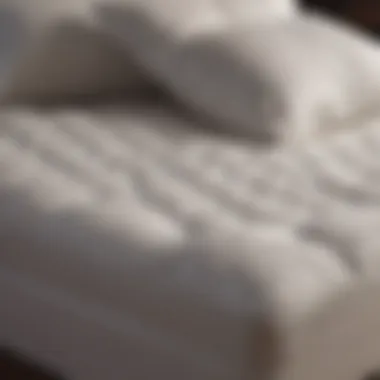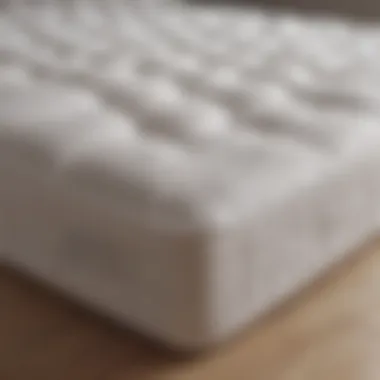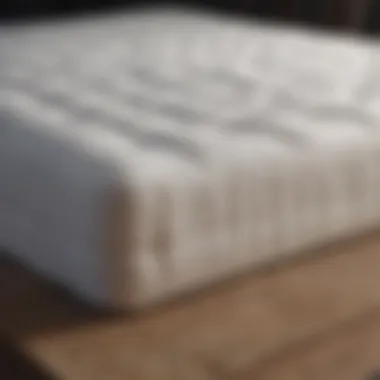Understanding Mattress Pads for Superior Sleep Quality


Intro
In the quest for achieving optimal sleep, many often overlook the pivotal role of mattress pads. These seemingly minor additions can significantly impact sleep quality and comfort. This article delves into the myriad aspects of mattress pads, aiming to provide a comprehensive understanding of their benefits, features, and the essential factors to consider when selecting one. While their primary function is to enhance comfort, mattress pads also partake in essential maintenance of the mattress itself, extending its lifespan and improving overall sleep hygiene.
Understanding mattress pads can lead to better sleep health and an improved sleeping environment. Considering homeowners and interior design enthusiasts, we aim to explore the trending designs and styles available. Moreover, we will address how proper maintenance can contribute to a more sustainable and hygienic sleeping surface.
As we dissect the various dimensions of mattress pads, from their design inspirations to upkeep strategies, this article will serve as a guide for those who seek not just a product, but a vital component of sleep quality.
Preface to Mattress Pads
Mattress pads serve as a fundamental layer in the pursuit of quality sleep. Understanding their role is essential for anyone interested in enhancing their sleep environment. This section will cover significant elements such as their definition, features, and the impact they can have on overall sleep quality.
Defining Mattress Pads
A mattress pad is a thin layer that rests on top of a mattress. It offers extra padding and protection. Mattress pads can be made from various materials, including memory foam, latex, and cotton. Their primary function is to improve comfort while providing a degree of insulation and support. They are different from mattress toppers, which are thicker and generally provide more substantial cushioning.
The many types of mattress pads serve various purposes. Some pads are designed to enhance softness, while others offer firmer support or temperature regulation. In addition, they can protect against allergens and act as a barrier to dust and dirt, thus maintaining the cleanliness of the mattress.
The Importance of Sleep Quality
Quality sleep is a vital component of overall health. It influences both physical and mental well-being. A lack of sleep can lead to numerous health issues, such as fatigue, anxiety, and impaired cognitive function. The importance of mattress pads in achieving quality sleep should not be underestimated. By providing an additional layer of comfort, mattress pads can minimize discomfort during sleep.
Moreover, a well-chosen mattress pad can also help align the spine properly. This is crucial in preventing back pain and ensuring a restful night. In summary, investing time in selecting the right mattress pad can lead to significant improvements in sleep quality, thereby enhancing the overall sleep experience.
"Quality sleep is not just a luxury; it's a necessity for a healthy lifestyle. Choosing the right components for your sleep environment is essential."
In this article, we will further explore the various types of mattress pads, their benefits, and how they contribute to a better sleeping experience. Understanding these factors will equip readers with the knowledge to make informed decisions about their sleep environment.
Types of Mattress Pads
Understanding the types of mattress pads is essential in determining how to achieve the best sleep possible. Different materials and constructions make each type suitable for varying preferences and needs. An informed choice can lead to enhanced comfort and an overall improved sleeping experience. Here, we will explain the key types of mattress pads available, discussing their unique characteristics and benefits.
Memory Foam Mattress Pads
Memory foam mattress pads are among the most popular choices for enhancing comfort. They conform to the body’s shape, providing support that relieves pressure points. This ability to adapt makes them suitable for various sleep positions. By redistributing weight, memory foam can help to minimize tossing and turning, potentially leading to a more restful night.
However, it is worth noting that not all memory foam is created equal. The density of the foam can greatly affect its firmness and longevity. A denser foam often provides better durability and support, while lighter options may be softer but might wear out faster. Choosing the right density according to individual comfort preference and sleep habits is crucial.
Latex Mattress Pads
Latex mattress pads are another excellent option. They offer a supportive and resilient feel that many find appealing. These pads can be made from natural latex or synthetic latex. Natural latex tends to be more durable and often features a higher price point, while synthetic options can be more affordable but may lack some of the natural benefits.
One of the advantages of latex mattress pads is their breathability. They tend to retain less heat compared to memory foam, making them ideal for people who sleep hot. Additionally, latex has hypoallergenic properties, which cater to those who may have allergies or sensitivities.
Feather and Down Mattress Pads
Feather and down mattress pads provide a plush and luxurious sleeping surface. Made from the soft undercoating of ducks or geese, they are exceptionally soft and cozy. Their natural insulation properties also provide warmth, making them suitable for cooler climates.
However, there are drawbacks. They may not provide the same level of support as foam or latex. Individuals who prefer firmer surfaces might find feather and down mattress pads lacking. Additionally, maintenance can be a concern, as they require special washing instructions to maintain their shape and fluffiness.
Cooling Mattress Pads


Cooling mattress pads address the common issue of sleeping too hot. Often made with specialized materials or technologies, these pads help draw heat away from the body. They can include features like gel-infused foam or phase-change materials that actively work to regulate temperature.
Investing in a cooling mattress pad is beneficial for those who experience night sweats or simply prefer a cooler sleeping environment. This type of pad doesn’t just regulate heat but can also prevent sleep disturbances caused by temperature fluctuations.
"Choosing the right type of mattress pad is a crucial step towards achieving better sleep quality."
In summary, each type of mattress pad comes with its own set of features and benefits. Memory foam offers contouring comfort, latex provides resilience and support, while feather and down present a cozy, luxurious feeling. Cooling pads cater to temperature-sensitive sleepers. It helps to understand these differences to make the best choice for enhanced sleep quality and overall comfort.
Key Features to Consider
When selecting a mattress pad, it is essential to understand the key features that can greatly affect your comfort and sleep quality. These features help distinguish one mattress pad from another, making it important for consumers to assess their individual needs. Knowing what to look for ensures that you choose a mattress pad that will serve its intended purpose effectively.
Thickness and Density
Thickness and density are pivotal when it comes to the performance of a mattress pad. A thicker pad often provides added cushioning, which can enhance comfort levels during sleep. People with larger body types may benefit from higher density options that can support better weight distribution. For instance, a 4-inch thick memory foam pad can accommodate more pressure than a 2-inch one.
In contrast, individuals who prefer a more firm surface might find thinner pads with less density more suitable. It's crucial to balance comfort preferences with support needs. The ideal thickness often varies based on the existing mattress firmness and personal sleeping styles.
Material Composition
The material composition of a mattress pad influences not only comfort but also durability and temperature regulation. Common materials include memory foam, latex, polyester, and cotton. Each material has unique attributes that cater to different needs. For example, memory foam is renowned for its conforming abilities under weight, promoting spinal alignment.
In addition, natural fibers like cotton or wool provide breathability, helping to regulate sleep temperature. Eco-friendly materials are gaining popularity, appealing to environmentally conscious consumers. Selecting the appropriate material composition can improve overall sleep experience and hygiene.
Hypoallergenic Properties
For individuals with allergies, hypoallergenic properties of a mattress pad are crucial. A hypoallergenic mattress pad can protect against dust mites, mold, and pet dander, which can trigger allergic reactions. Many mattress pads are made from hypoallergenic materials, which are designed to deter allergens.
When considering a mattress pad, look for certifications like "OEKO-TEX" or "CertiPUR-US" to ensure that no harmful chemicals are present. Such certifications indicate the pad’s safety and its potential for reducing allergens in the sleeping environment, fostering a healthier sleep setting.
Washability and Care Instructions
Proper care plays a significant role in the longevity and hygiene of a mattress pad. Many consumers overlook care instructions, which can vary significantly between products. Some mattress pads come with removable covers that are machine washable, while others may require specific cleaning recommendations to avoid damage.
Caring for your mattress pad is not just about cleaning; it also involves understanding its construction to maintain its integrity. Regular maintenance, such as washing and airing out the pad, can help prolong its life and enhance sleep quality. Individuals should always check the manufacturer's guidelines to ensure appropriate care procedures to avoid voiding warranties.
Proper care of your mattress pad increases its lifespan and contributes to a hygienic sleep environment.
Benefits of Using a Mattress Pad
The significance of mattress pads extends beyond mere comfort, serving as a vital component for enhancing sleep quality and prolonging the life of your mattress. By understanding the benefits offered by mattress pads, homeowners and interior design enthusiasts can make more informed decisions. These benefits include enhanced comfort, protection for the mattress itself, and temperature regulation, each playing a crucial role in establishing a restful environment.
Enhanced Comfort
One of the primary advantages of using a mattress pad is the boost in comfort it provides. A well-chosen mattress pad provides a buffer between the sleeper and the mattress. This additional layer can relieve pressure points, making it easier to find a comfortable sleeping position. Depending on the type of material used, a mattress pad may add softness, firmness, or even a cooling effect that suits the individual’s preferences. Memory foam pads, for example, contour to the body’s shape, promoting spinal alignment and overall comfort. Moreover, channeling the right comfort level can help reduce tossing and turning during the night.
Protection for Your Mattress
Investing in a quality mattress pad serves as a protective barrier for your mattress. This is critical for maintaining the mattress’s integrity over time. Mattress pads help trap dust, allergens, and spills, preventing them from penetrating the mattress itself. They can be easily removed and washed, making maintenance simpler than trying to clean a full mattress. Consequently, this protection creates a healthier sleeping environment by minimizing allergens and bacteria buildup. Furthermore, some pads are made with materials that enhance durability, thus contributing to a longer lifespan for the mattress.
The right mattress pad can significantly extend the longevity of your investment in sleep health.


Temperature Regulation
Temperature control is another significant aspect of mattress pads. Factors such as body heat and room temperature can impact sleep quality. A cooling mattress pad can draw heat away from the body, helping to regulate body temperature during sleep. Materials such as gel-infused memory foam or breathable cotton can enhance airflow, reducing the likelihood of overheating. Conversely, warmer mattress pads, like those filled with down, can provide warmth during colder months.
By considering temperature regulation, a mattress pad can cater to seasonal changes, ensuring comfort year-round. This adaptability can lead to a more consistent and restorative sleep experience.
Choosing the Right Mattress Pad
Choosing the right mattress pad is crucial for maximizing sleep quality and comfort. It represents a tailored approach to enhancing one’s sleeping environment. A well-selected mattress pad can significantly influence the way you feel during the night and also how rested you wake up in the morning. By considering personal needs, compatibility with existing bedding, and budget constraints, a homeowner or bedding enthusiast can decisively improve their sleep experience.
Assessing Individual Needs
Assessing individual needs is the first step in selecting an appropriate mattress pad. Everyone has distinct preferences and requirements based on their body type, sleeping position, and any particular health concerns. For instance:
- Body Type: Heavier individuals may require a thicker, denser mattress pad to provide adequate support and prevent sagging.
- Sleeping Position: Side sleepers often benefit from softer materials that cushion the shoulders and hips. Conversely, stomach sleepers may prefer firmer options that offer more stability.
- Health Concerns: People with allergies might lean toward hypoallergenic mattress pads that resist dust mites and other allergens.
Recognizing these factors helps in making an informed choice that promotes comfort throughout the night.
Matching with Existing Bedding
Matching the mattress pad with existing bedding is essential. Consider the current mattresses and sheets in use. The primary goal is to ensure harmony in both aesthetics and functionality. Elements to consider include:
- Size: Ensure the mattress pad fits snugly on your mattress. A misfit can lead to discomfort and reduce the effectiveness of the pad.
- Material: The fabric of the mattress pad should blend well with the sheets. For example, pairing a cotton mattress pad with cotton sheets can maintain a cool and comfortable sleeping environment.
- Color and Design: While practicality reigns supreme, the appearance of the mattress pad should align with the overall bedroom decor. This creates a cohesive and visually pleasing space.
A thoughtful approach to these aspects will enhance both the aesthetic and functional value of the bedroom setup.
Understanding Budget Considerations
Understanding budget considerations is imperative. Mattress pads vary greatly in price depending on their material, features, and brand. Here are some points to help guide your financial considerations:
- Material Impact: Certain materials, like memory foam or latex, generally come at a higher price point. Weigh the potential comfort benefits against the cost.
- Longevity: Investing in a more expensive, high-quality mattress pad may reduce the need for frequent replacements, ultimately proving cost-effective in the long run.
- Promotions and Discounts: Keep an eye on sales or promotions. This can allow for more flexibility in choice without exceeding your budget.
Ultimately, while budget is a critical factor, it should not compromise the quality of sleep. A well-chosen mattress pad balances cost with features that can profoundly impact sleep quality.
"Selecting the right mattress pad is not just a choice; it’s a strategy toward better sleep and overall health."
Taking the time to assess needs, align with existing bedding, and understand budget considerations can create a restful and aesthetically pleasing sleep environment.
Caring for Your Mattress Pad
Caring for your mattress pad is essential for maintaining both its functionality and longevity. A well-cared-for mattress pad can greatly enhance your sleep experience by providing added comfort and protection to your mattress. Regular maintenance and proper cleaning can prevent the accumulation of allergens and bacteria, ensuring a healthier sleep environment. Additionally, understanding how to care for your mattress pad can prolong its lifespan, making it a wise investment for a good night’s sleep.
Cleaning and Maintenance Tips
To keep your mattress pad in optimal condition, follow these essential cleaning and maintenance tips:
- Read the Care Label: Always start by checking the manufacturer's care instructions. Each pad may have specific cleaning requirements depending on its material.
- Regular Washing: Most mattress pads can be machine-washed. Aim to wash your mattress pad every few months or as needed to keep it fresh. Use a gentle cycle and mild detergent.
- Air Drying: Whenever possible, air dry your mattress pad instead of using a dryer. This helps preserve the material and prevent shrinkage.
- Spot Clean Stains: For stains, spot clean immediately with a mix of mild detergent and water. Blot with a clean cloth to avoid soaking.
- Use a Mattress Protector: Consider using a waterproof mattress protector under your mattress pad. This adds an extra layer of protection against spills and stains, reducing the need for frequent washing.
These steps can help ensure that your mattress pad remains clean, comfortable, and effective at enhancing your sleep quality.
When to Replace Your Mattress Pad


Recognizing when to replace your mattress pad is crucial for maintaining comfort and hygiene. Here are some key indicators:
- Visible Wear and Tear: If you notice tears, fraying, or significant wear, it may be time for a new mattress pad. Damaged pads may not provide the intended comfort or protection.
- Persistent Odors: If your mattress pad has absorbed odors that do not wash out, it can harbor bacteria and allergens. Replacing it can improve your sleep environment significantly.
- Loss of Shape or Support: Over time, mattress pads can lose their density and support. If you feel that your pad no longer provides sufficient cushioning, consider investing in a replacement.
- Allergic Reactions: If you start experiencing allergic reactions during sleep, your mattress pad may be a source of allergens. Frequent cleaning may help, but replacement could be necessary if allergens persist.
Understanding these signs will help you maintain a sleeping environment that promotes health and comfort.
The Relation Between Mattress Pads and Sleep Quality
Understanding how mattress pads relate to sleep quality is crucial for anyone seeking to improve their nightly rest. A mattress pad is not merely an accessory; it is a significant component of your sleeping environment that can substantially impact comfort and overall sleep hygiene.
How Comfort Impacts Sleep
Comfort is a key factor in achieving restorative sleep. Mattress pads contribute to comfort by providing additional cushioning and support. Each type of mattress pad, whether it be memory foam or latex, offers varied degrees of softness and firmness, which can align better with individual preferences. The right level of comfort helps in maintaining a proper sleeping posture, reducing strains on the body.
When the body is well-supported, it can relax more completely. This relaxation leads to easier transitions between the various sleep stages. Poor comfort can lead to frequent awakenings and overall disruption of the sleep cycle, causing one to feel unrefreshed in the morning. Therefore, choosing the correct mattress pad can be seen as a proactive step towards better sleep quality.
Preventing Sleep Disturbances
Sleep disturbances can arise from several sources, including external factors and uncomfortable sleeping conditions. A quality mattress pad can help mitigate these disturbances, creating a more peaceful environment. For instance, those who experience temperature fluctuations during the night may benefit from cooling mattress pads, which are designed to regulate heat. This can help prevent the discomfort associated with overheating.
Moreover, a mattress pad also acts as a barrier against allergens and dust mites. Hypoallergenic options are available for those who are sensitive to such irritants. By ensuring a cleaner sleeping surface, mattress pads can reduce allergic reactions that might lead to waking up during the night.
In summary, the relation between mattress pads and sleep quality is evident. Comfort directly affects sleep effectiveness while a well-chosen pad can prevent disturbances, leading to a deeper, more restorative sleep experience. A mattress pad can thus be considered an essential element for maintaining not only a comfortable bed but also contributing to better health overall.
Innovations in Mattress Pad Technology
Innovations in mattress pad technology represent a significant aspect of modern bedding solutions. These advancements not only reflect the evolution in material science but also speak to the growing awareness of sleep health. Consumers expect more than basic comfort; they desire features that cater to their specific sleep needs.
Smart Mattress Pads
Smart mattress pads incorporate advanced technology to enhance the sleep experience. They often include sensors that monitor sleep patterns and adjust support accordingly. By connecting to smartphones or other smart devices, users can receive personalized feedback. This data can include information such as sleep duration, movement, and even breathing patterns.
The integration of smart home technology is a key benefit. For example, the Sleep Number DualTemp Layer can modify its temperature based on the user’s body heat or preferences. Such features provide an unparalleled level of customization, catering to those who value both comfort and tech integration.
While these smart pads are generally more expensive, they offer potential savings over time by promoting better sleep quality. Improved sleep can lead to better productivity and health outcomes, making the investment worthwhile for many homeowners and design enthusiasts.
Eco-Friendly Options
With the growing concern for environmental sustainability, eco-friendly mattress pads have become increasingly popular. These products use natural materials such as organic cotton, natural latex, and bamboo fibers. For instance, the Avocado Green Mattress Pad is made from 100% organic cotton and is certified by several organizations focused on sustainability.
Choosing eco-friendly options also supports health. Many synthetic materials used in traditional mattress pads may release harmful chemicals over time. By opting for organic materials, consumers can create a healthier sleep environment devoid of toxins. Additionally, these materials are often biodegradable, which contributes to reducing landfill waste.
The market for eco-friendly mattress pads reflects a wider trend toward sustainability in home goods. Homeowners looking to improve their quality of sleep while being environmentally conscious can find various options available today. By prioritizing these innovations, they not only enhance their personal sleep quality but also contribute to a healthier planet.
End
In summarizing the discussion on mattress pads, it becomes clear how essential they are to sleep quality. Mattress pads serve as valuable tools that not only enhance comfort but also offer protection for your mattress. Their impact extends far beyond mere comfort; they play a crucial role in maintaining overall sleep hygiene and extending mattress life.
Recap of Mattress Pad Importance
Mattress pads have multiple benefits that contribute to a better sleep experience. They can significantly improve the comfort level of your bed. By providing cushioning and support, they help create an environment conducive to restful sleep. Additionally, they protect your mattress from spills, stains, and allergens, essentially acting as a barrier against wear and tear. This protection can lead to an increase in the lifespan of the mattress, making the initial investment more worthwhile.
To recap their importance:
- Enhanced Comfort: They adjust the feel of the mattress to suit one’s preference.
- Protection: They act as a shield against allergens, spills, and physical damage.
- Temperature Regulation: Many mattress pads are designed to help regulate sleep temperature, keeping you comfortable throughout the night.
Final Thoughts on Sleep Health
Sleep is a vital component of human health and wellbeing. A good quality sleep can improve mood, cognitive function, and even overall physical health. Investing in a mattress pad is not just about comfort; it is about investing in your health. The right mattress pad can help alleviate issues such as back pain and restlessness, thereby creating a more restorative sleep cycle.







